WALT DISNEY WORLD AT 40
Between now and October 1, the Disney History Institute will be celebrating the 40th Anniversary of Walt Disney World. Our focus will be on the dreams and legacy of Walt Disney and how they were fulfilled within WDW, and also on those that worked with Walt and their stories. This is the first in a series of essays.
THE LIBERTY TREE STORY
Only God Can Make A Tree
(I originally posted this essay on the Liberty Tree back in 2009. I thought it was a good idea to bring it out of the Archives and post it again, since I recently found buried within the DHI Archives,
several photos that illustrate the process that Bill Evans is explaining.)
several photos that illustrate the process that Bill Evans is explaining.)
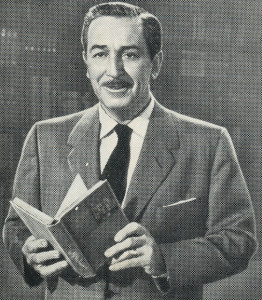 |
| Walt Disney With Esther Forbes’ book Johnny Tremain |
The “Liberty Tree” in Liberty Square at Walt Disney World stands as the largest living specimen in the Magic Kingdom and is the largest tree ever transplanted on WDW property. The 100-year old southern Live Oak (quercus virginiana) was found on the east side of the WDW property about eight miles from its current location.
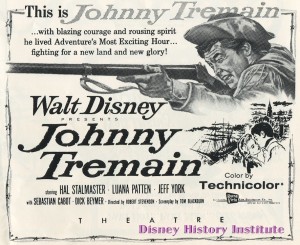 |
| Johnny Tremain (1957) |
The stately tree represents the original Liberty Tree in Boston that was christened in 1765 by patriots calling themselves the “Sons of Liberty.” They would gather beneath its limbs to protest the unjust imposition of the Stamp Act. Throughout the early years of the revolution it became a living symbol of American freedom of speech and assembly. The tree in WDW has thirteen “victory” lanterns hanging from its boughs to represent the thirteen original colonies. Walt Disney was a fond of Esther Forbes’ prize-winning novel (and schoolhouse staple) Johnny Tremain, and purchased the film rights. Disney’s action packed adventure film of the same name featured the Liberty Tree in America’s War of Independence. Walt believed that nothing could match history’s cavalcade of men and events as a source for fascinating entertainment and exciting film fare. “If all the world is a stage,” declared Walt in a period interview, “then all history is a great story warehouse and casting department rolled into one.”
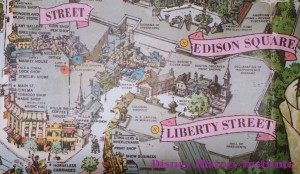 |
| Liberty Square, complete with Liberty Tree, as envisioned for Disneyland in this 1958 souvenir map, with art by Sam McKim. |
The film was released in 1957, which was also a period when Walt was envisioning a Liberty Square, complete with a Liberty Tree, for Disneyland. This land never came about for Disneyland, but true to Walt’s wishes, the tree was planned for inclusion in WDW’s Liberty Square—but not without overcoming a serious obstacle.
Preparations to move the 38-ton tree began a year in advance when it was discovered that the root ball measured 18 feet by 16 feet by 4 feet deep. It was so large that it was impossible to lift it by simply wrapping a cable around it, as was common. (In fact had this been attempted the bark and cambium layers of the tree would have been crushed by the trees own weight.)
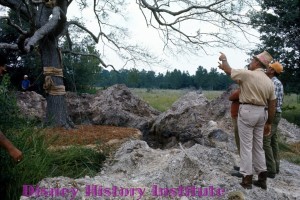 |
| Bill Evans (pointing) supervises the removal of the Magic Kingdom’s soon-to-be Liberty Tree on June 11, 1970. |
Enter the ingenuity of Walt’s personal, hand-picked landscaper, Bill Evans, who earned Walt’s confidence and, along with his brother Jack, was put in charge of the landscaping for Disneyland. After Walt’s passing in 1966, he was still with Disney and supervised the entire landscaping for WDW (Jack had sadly passed on). Years earlier at Disneyland Evans had come up with an innovative method where holes were drilled through the hardwood center of the trunk and steel rods inserted. These rods on the Liberty Tree served as handles for hoisting and hauling the tree with a 100-ton crane to its present location.
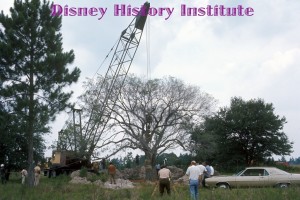 |
| Removal of the Liberty Tree using Bill Evans’ innovative system developed at Disneyland on the request of Walt Disney to move a coral tree. Photo circa June 11, 1970. |
Evans explained in an interview with me the winsome account of how he developed the technique:
“When Disneyland was only a couple of years old, Walt decided that the African Coral Tree growing at the Polynesian Terrace was not big enough to carry a vast assortment of sound and lighting equipment and other paraphernalia that represented a good deal of weight.“So he wanted the Coral Tree out and an artificial tree in–a constructed tree. I don’t know whether or not you could invoke the poem ‘Only God Can Make A Tree,’… but Walt made a tree… [Laughing] and it was quite a satisfactory tree.“In order to not loose the tree that occupied the sight, we needed to find a way to get the tree out. We could not get a crane strong enough to lift it out of there if we had put a conventional box on it. We took a calculated risk and propped the tree up with some 6 x 6 timbers under the branches to carry its weight and proceeded to placer mine, with a firehouse, all the real estate until we had it suspended from its branches.“Then we went around with pruning sheers and reduced the root system to something we could handle. Now we were afraid we would crush the sensitive cambium—which is the film that is the life blood of the tree or any tree—which lies just under the bark.“So rather than seizing it around the throat, so to speak, we bored a couple of holes through the trunk—one north-south and one east-west—and put some inch and a half steel through the trunk and thus provided a convenient handle. We then picked the tree up by these steel pins and transported it. And now you see it weighed about one-fifth of what it would have weighed.“We ended up doing several hundred trees that way. I don’t think that anybody ever attempted this before—it was the kind of latitude that Walt gave us.“Due to its success we carried the method down to Florida where the local nurserymen and landscape people were absolutely horrified, including the professional pathologist from the University of Florida I might add. He predicted our trees would die in two years if we bored a hole through them. And we must have moved a thousand trees that way in Florida, all kinds of trees including the Liberty Tree. [Laughing] And hardly any of them died.”
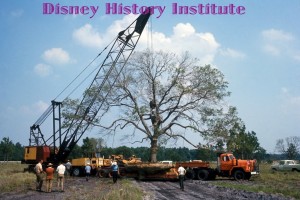 |
| Finally the new Liberty Tree is loaded up and ready to begin it’s journey (June 11, 1970). The tree would not be installed and planted in the Magic Kingdom’s Liberty Square until March 6, 1971. |
Today, thanks to Walt Disney, Bill Evans and others, the Liberty Tree stands noblely at the heart of Liberty Square—a symbolic image of America’s beginning and Disney’s dream.
THE LIBERTY TREE AT WALT DISNEY WORLD
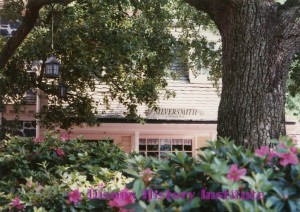 |
| Springtime view in 1991 of a symbolic lantern hanging from the Liberty Tree–Just as it was done in the Walt Disney film Johnny Tremain (1957) and during the American Revolution. |
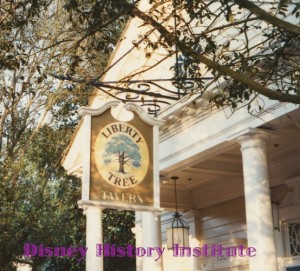 |
| Magic Kingdom’s popular Liberty Tree Tavern restaurant. Several restaurant ideas were proposed for Disneyland’s Liberty Street. (Photo circa spring 1991.) |
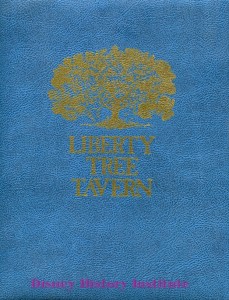 |
| WDW Liberty Tree Tavern Menu 1970s, Walt Disney Productions |
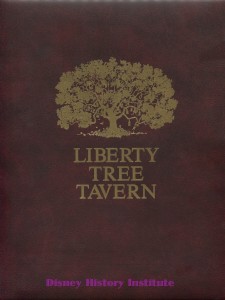 |
| WDW Liberty Tree Tavern Menu 1990s, Walt Disney Company |
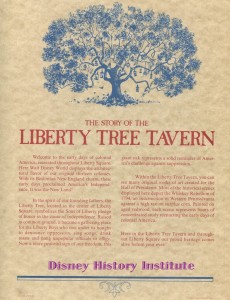 |
| Story of the Liberty Tree Tavern Restaurant, from the 1970s Menu. |
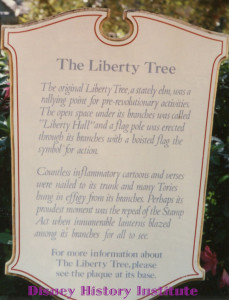 |
| Sign that stands before The Liberty Tree at Walt Disney World’s Magic Kingdom. Circa 1991. |
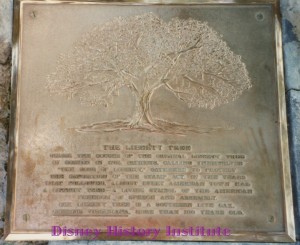 |
| Original plaque at the base of The Liberty Tree at Walt Disney World’s Magic Kingdom. Circa 1991. (As with all our photos, click on them for a higher resolution image.)
|

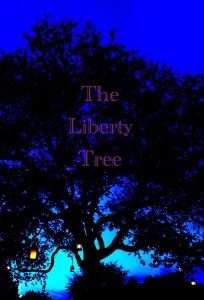
Recent Comments